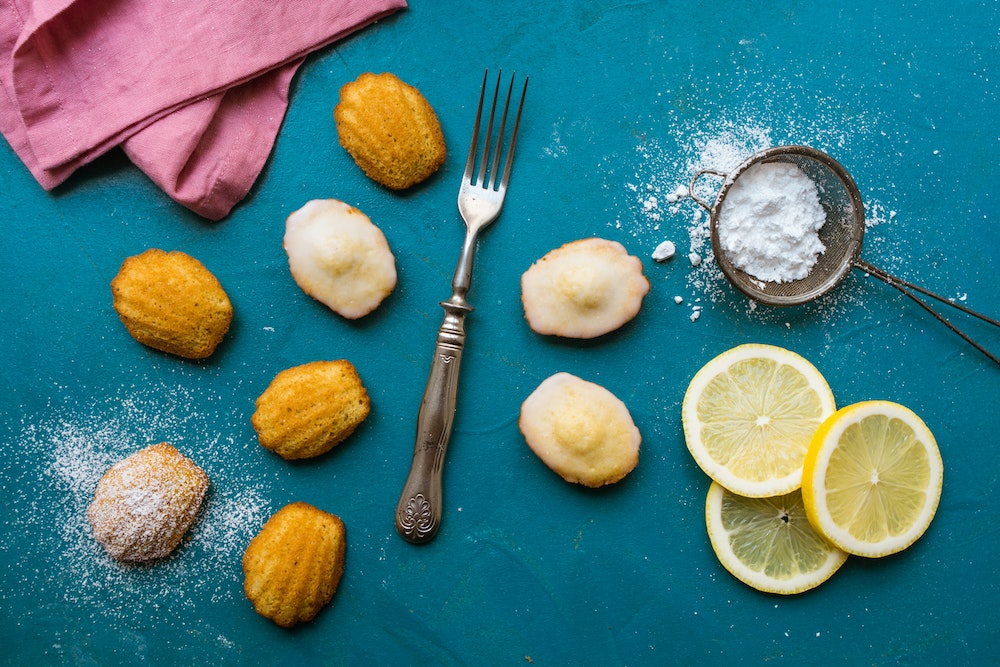One recent evening, I brought to a simmer a pint of dry, hazy cider, then draped into the pan a whole glistening trout. I diced an onion, having torn off the papery outer layers; having peeled back the thin, translucent membrane still clinging to the pearlescent surface of the bulb, and browned it in a foaming bath of salted butter. Once the onion had browned, I folded in a pound of chopped fresh spinach. I lifted away the skin of the poached fish and layered my greens into its belly; I boiled down the cider, ambrosial with the addition of a leafy sprig of tarragon, and whisked in heavy cream, all of it commingling into a silky almond-colored sauce, which I poured into a deep dish and, afterward, laid my trout to rest in the center until it was time for dinner.
It had been a buttery day already. I’d spent my past few meals eating through recipes from Dining With Marcel Proust: A Practical Guide to French Cuisine of the Belle Époque, a cookbook and quasi-encyclopedia by English chef and writer Shirley King. I’d griddled up a croque-monsieur for breakfast (no crusts in the Belle Époque!) followed by a lunch of unctuous leek-and-potato soup, and was excited for my triumphal truite farcie aux espinards, which seemed to me an Escoffier special, as Continental as could possibly be.
I’d been hoping for a Proustian moment, even knowing full well that these things are famously involuntary.
When I took my first bite, a shudder ran through my whole body. After a few more tastes, suddenly, the memory returned: the taste was that of the trout which on Sunday mornings at Combray—
I’m kidding. Maybe I’d been hoping for a Proustian moment, even knowing full well that these things are famously involuntary.
When I’d picked up the first volume of In Search of Lost Time, I was not particularly expecting to enjoy it. It was more of a personal challenge, a desire to know what all the fuss was about. I vaguely suspected that I (having read neither Deleuze nor Barthes) would not actually understand it. But I quickly realized I’d been hoodwinked by the legend and literary theory; this is not an impenetrable book at all. Once I felt welcomed into the world of the narrator, Marcel—which didn’t take long—I did not want to leave it.
King, the cookbook author, described a similar experience with Proust in a 1979 interview ahead of the publication: “I read it morning and night, and it suddenly occurred to me that Proust was as much obsessed with fine food as I had been.” She elaborates on this in the introduction to Dining With Marcel Proust: “Within the first few pages, one becomes aware of the brilliantly told, minute observances of food which Proust weaves into his story.”
In King’s hands, Proust’s “minute observances” are translated into hundreds of recipes, from the simple (creamed carrots, baked eggs, shortbread) to the elaborate, all referenced some way or another in his work. It’s an atlas of the “bourgeois cuisine” of Proust’s lifetime, which prioritized seasonality and quality of ingredients, but also appreciated comfort and deliciousness over style—a luscious world of lobster à l’Américaine, pike quenelles with prawn sauce, mushroom-and-liver-stuffed pheasant, and gâteau St. Honoré. It’s unmistakably the same world that the author has built on his own, albeit over the course of many, many more pages.
Food in Swann’s Way is a load-bearing image, a prop and a pleasure, a thing that families, cliques, and towns are built around. It not only enriches the world but in some cases holds the key to it. It is there in the routines of young Marcel’s family in the town of Combray, and in the rituals of Paris high society as Swann, a well-connected family friend and object of Marcel’s fascination, meanders through it. The story seems strung together by the hosting of salons and suppers, the arguing over wines and unfinished plates, the ordering of pears from Chevet and strawberries from Jauret. Most deliciously, to me, the culinary prowess of the capable family cook Françoise, “under whose careful eye,” the French literature scholar Hollie Markland Harder has written, “food preparation seems to be elevated to one of the fine arts.” Soon enough, I found myself instinctively interpreting cooking-and-eating as one of those arts (like music, painting, and skilled conversation) around which these characters’ lives revolve.
I could not shake the impression that Proust loved not only food, but also writing food.
But after traversing those first 600 pages—I have read only the opening slice of Proust’s million-word novel, a small, small sample, I admit—I could not shake the impression that Proust loved not only food, but also writing food. The cookery runs deep into the language. Food is a truth of its own: young Marcel feels his mother’s love “like a ripe fruit which bursts through its skin,” and later, preparing for his first trip to the theater, finds he is “as little capable of deciding which play I should prefer to see as if, at the dinner table, [someone] had obliged me to choose between rice à l’Impératrice, and the famous cream of chocolate.” (How better to convey cravings than with something sweet?) At one point, a frantically lovesick Swann approaches a window he believes to be that of his then-mistress, Odette, and peers jealously “between the slats of its shutters, closed like a wine-press over its mysterious golden juice.” Eating and loving intermingle, with many characters seeming to conflate one with the other. Later, in a moment of jealousy that interrupts his enjoyment of a glass of Odette’s orangeade, Swann works himself up imagining that someone else would ever taste her recipe.
The Proust scholar James P. Gilroy has described this author’s tendency toward “gastronomical synesthesia”—sensations blend together and gastronomy comes in when other words fail, evoking feelings that sometimes don’t quite make sense, but also, deeply, do. In one of my favorite passages, Marcel recalls walking in Combray in winter, watching the sun set with “a fiery glow which, accompanied often by a cold that burned and stung, would associate itself in my mind with the glow of the fire over which, at that very moment, was roasting the chicken that was to furnish me, in place of the poetic pleasure I had found in my walk, with the sensual pleasures of good feeding, warmth and rest.” The sunset is not so separate from the fire is not so separate from the chicken is not so separate from home, and Combray would not be Combray without any of it.
Here are a few of the foods that Marcel, the man, enjoyed in his non-novelized life: red mullet from Marseilles, fried smelt, ravioli, chocolate soufflé, Russian salad, beef with chicken gizzards, Gruyère and beer, eggs and Béchamel. As James Beard notes in the introduction to Dining, “It is well known that he loved sitting at table with a circle of friends.” Proust even loved food when he hardly had an appetite. We’ve learned from Céleste Albaret, his housekeeper and biographer, that the author’s poor health eventually robbed him of his beloved hunger; still, Albaret remembers running to the market, quickly frying up a fish, and serving it with wedges of lemon. “Sole were about the only food he could eat at the end of his life.”
Before reading Proust I’d had no inkling that I would find in him a kindred spirit.
I, too, would like to eat a whole fried sole on my deathbed. But before reading Proust I’d had no inkling that I would find in him a kindred spirit in this particular regard; maybe the hushed and reverent tones concerning his work had obscured for me the Béchamel and beer of it all. Or maybe the many flavors of Proust’s writing and writing life have been overpowered by his own masterstroke.
I first learned about Proust’s madeleine, arguably the most famous food in Western literature, in a high school history class, 15 years before I would actually pick up the book in question; at the time I had heard of neither Proust nor madeleines, and was subsequently taught to never think of one without the other long before I understood what was actually happening between them. This is probably true for many people: Proust makes a prominent appearance, naturally, on the “madeleine” page of Wikipedia, and the page for “involuntary memory” opens with a picture of madeleines.
Famously, all it takes is a teacake to slingshot Marcel back to his childhood. Specifically, to a visit to family in Combray, and even more specifically, to the house of his Aunt Léonie, who had a habit on Sunday mornings of letting a young Marcel dip a madeleine into her cup of lime-flower tea. Once that door opens, everything else comes rushing in: the village, the church steeple, the flowers and trees, the people of Combray, the people in the house, the people who made Marcel who he is. This is the real beginning of the story Marcel wants to tell, and the power of the madeleine is one of Proust’s sweetest legacies.
But I was not prepared for how evocative I would find the actual description: I could see the “squat, plump little cakes” in my mind, “which look as though they had been moulded in the fluted valve of a scallop shell.” I could nearly taste one, “so richly sensual under its severe, religious folds.” I was unexpectedly moved by how tenderly the author describes soggy crumbs at the bottom of a teacup, and felt my own memories of warm tea and crumbs and home and winter in my peripheral vision—understanding, intuitively, all that could be contained within a teacake.
I followed Proust in imagining food as a portal, an invitation; not just associated with memory but often wrapped up in it.
Could Proust have gotten the reader there with anything other than food? I doubt it. Marcel doesn’t seem to think so, either, with his famous observation that “taste and smell alone,” fleeting senses so difficult to share with others, “bear unflinchingly, in the tiny and almost impalpable drop of their essence, the vast structure of recollection.” It’s one of many places where I followed Proust in imagining food as a portal, an invitation; not just associated with memory but often wrapped up in it, the container for memory, or memory itself. “Proust constructed his book as a vast sphere of signs, of experiences to be tasted,” Carol Mavor observes in Reading Boyishly—“perhaps resulting in a madeleine or two for ourselves.”
I remember the first time I realized I was allowed to like food: I was 23 years old, which is not that many years but also more than anyone should ever spend without truly being present during a meal. It was fall. I was in a restaurant on a foreign harbor with white-washed walls and white-clothed tables. The sun beamed through the warped pane of an old window, through my wine glass, and onto a mother-of-pearl spoon bearing a small hill of luminous salmon roe. I have written this scene what feels like a hundred times over, but I still feel I haven’t even scratched the surface. I could write a hundred pages and still have more to see.
A few months later, I got it into my head that I wanted to be a food writer. Some knot had untangled in me, or something had been knocked loose—I think, in a previous iteration of this scene written by a younger me, I claimed to have seen God. I guess I do feel a shimmer of the divine when I look back on it. In my family, food was cooked with efficiency and eaten without feeling; nobody had told me it could do a thing like that. I was thrilled to find something I wanted only more of, and thrilled by letting myself ask for more. I was beginning to understand that some things live more in the body than the brain.
Something I had been taught to see as a minor character was actually everywhere, all around me. It was ahead of me and behind me, before me and after me. Food was an active thing: it could tap into my depths, release chemicals into my cells, beckon something just out of reach, transmit me across time and space, and set me off in search of what I could learn, about my world and about myself, by paying attention.
Proust certainly was a master of paying attention. It’s one of the reasons his autobiographical novel is sometimes a reference point for writers of memoir, a demonstration of how a writer can find meaning in the mundane and transmit a version of themself on the page. I see traces of Proust, too, in the explosion of the food memoir and the popularity of food-centric personal essays; In Proust, Gilroy writes, “even the most profound revelations of essential truth can be inspired by activities associated with the consumption of food.” Food writing today recognizes our connections to food as legitimate, and recognizes food for all the varying things it can be—an exercise of zooming into something sensory and turning it over and over until we see it differently.
In some ways food writing relies on recreating the madeleine moment: memories unlocked, formative experiences revealed. But the best of it doesn’t just reiterate this potential but jumps off from it, writing through the steam and smoke until something emerges. In eating his tea-soaked crumb, Marcel notices “the effect, which love has, of filling me with a precious essence; or rather this essence was not in me, it was me.” Food feels like love, and it feels like us. Still, it’s even more when we make meaning of it; Marcel realizes “that the truth I am seeking lies not in the cup but in myself.”
The Guardian reported in 2015 on a set of recently published drafts, dating to 1907, in which Proust’s seeking is clearly underway. Turns out that the writer played around with the madeleine section. Maybe he knew what an epiphany he had on his hands and wanted to land it exactly right: before Proust arrived at a teacake, Marcel had found Combray spreading over a snack of toast with honey, and later, hard biscotti, both of which don’t seem quite right to me, either. I’d been tempted to think the madeleine was a real and vivid memory; in reality it was just a literary device, but Proust knew enough about food to make it true. And as I continue through the rest of In Search of Lost Time—a task to be savored—I find myself looking forward to the next time he will welcome me to his table.






















































![‘Criminal Record’ Trailer w/ Peter Capaldi and Cush Jumbo [VIDEO] – TVLine ‘Criminal Record’ Trailer w/ Peter Capaldi and Cush Jumbo [VIDEO] – TVLine](https://washingtonweeklytimes.com/wp-content/themes/jnews/assets/img/jeg-empty.png)



